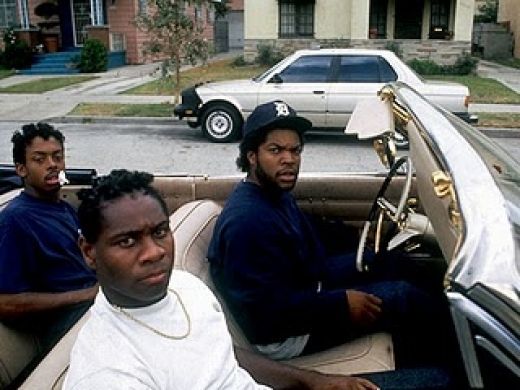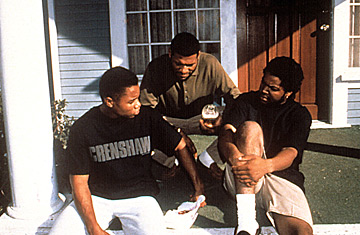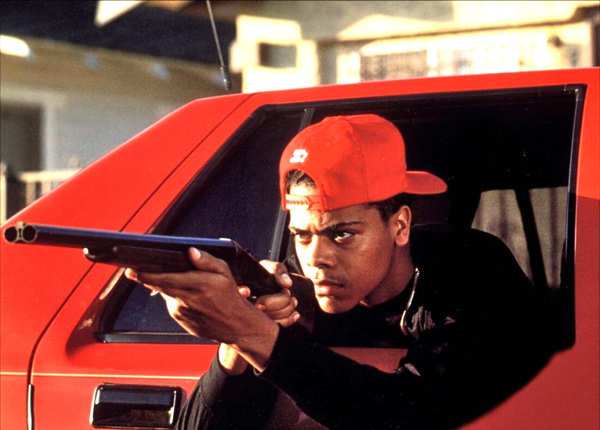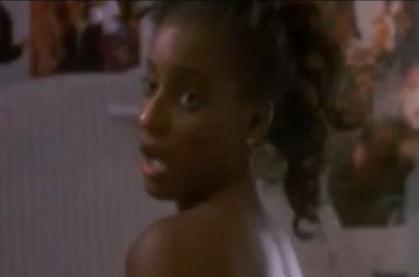From the Chicago Reader (July 19, 1991). — J.R.
BOYZ N THE HOOD* (Has redeeming facet)
Directed and written by John Singleton
With Cuba Gooding Jr., Ice Cube, Morris Chestnut, Larry Fishburne, Angela Bassett, Nia Long, and Tyra Ferrell.
It’s been estimated that at least 19 pictures by black directors will be released in the U.S. this year. That’s less than 5 percent of the total number of features, but still more than the entire output of black-directed movies of the 80s. So far we’ve had New Jack City, The Five Heartbeats, A Rage in Harlem, Jungle Fever, Up Against the Wall, Straight Out of Brooklyn, and now Boyz N the Hood; still to come are Livin’ Large, Talkin’ Dirty After Dark, Hangin’ With the Homeboys, True Identity, House Party 2, Juice, Go Natalie, Daughters of the Dust, Street Wars, Chameleon Street, Perfume, and The Three Muscatels.
Some reviewers have been treating this wave of black pictures as some sort of Golden Age. In terms of the actors, life-styles, slang, and neighborhoods hitting the screen, they may have a point. It’s also true that a sense of urgency in getting a message out gives some of these pictures a vitality and authenticity that they wouldn’t otherwise have; even a movie as technically feeble as Straight Out of Brooklyn has some claim on our attention for this reason. But compared to the best black-directed American features of the 70s and 80s, the half dozen of the new batch that I’ve seen so far strike me as both less revelatory and less durable. Bill Gunn’s Ganja and Hess (1970), Ivan Dixon’s The Spook Who Sat by the Door (1973), Charles Burnett’s Killer of Sheep (1977), Larry Clark’s Passing Through (1977), Burnett’s My Brother’s Wedding (1983), and Billy Woodbury’s Bless Their Little Hearts (1984) are all examples of movies that not only benefit from their glimpses into black culture but also transform our very perceptions of it. Sadly, few if any of these movies were ever shown in the neighborhood theaters that are now playing Jungle Fever and Boyz N the Hood, and none of them, as far as I know, have turned up on network or cable TV or on video. (The scripts of Ganja and Hess and Killer of Sheep, however, have recently been published by Indiana University Press, in a volume with four other scripts called Screenplays of the African American Experience, edited by Phyllis Rauch Klotman.)
Obviously it’s difficult to generalize about films that on the surface at least share only the race of their directors, but differences between these groups of films are striking. While the films of Gunn and Dixon are highly transgressive “blaxploitation” features — an intellectual vampire film and a politically subversive reworking of James Bond, respectively — the independent films of Burnett, Clark, and Woodbury (all UCLA classmates) are highly poetic and original depictions of particular areas of black life. And most of the recent films are relatively didactic, issue-oriented talkfests more concerned with broaching black subjects than with radically transforming them.
The currency and immediacy of these recent films is probably their strongest calling card, although it might be argued that these qualities tend to rule out the sort of conceptual originality that makes the earlier work so powerful. Two exceptions to this general rule may be Ruby L. Oliver’s Love Your Mama (1989), which dared to be upbeat without ducking hard questions (and which, perhaps significantly, has still failed to find a distributor), and Jungle Fever, which I like less now than when I reviewed it last month, but which still strikes me as having a complexity and diversity of address overall that is greater than the sum of its (mainly) hidebound characters.
The strengths and weaknesses of Boyz N the Hood, John Singleton’s personal look at growing up black in south central Los Angeles, seem equally matched. From a technical and emotional standpoint, this picture is much stronger than Up Against the Wall or Straight Out of Brooklyn, and its message of black self-determination is in many respects more cogently expressed, with a sense of loss and pain that gains in power during the closing reels. But unfortunately, this message and part of the emotion underlying it get so entangled in Singleton’s commercial preoccupations on the one hand and his personal fixations on the other that the film often seems at war with its own best instincts.
Two unconnected facts about Singleton’s youth seem germane here: one is that he first became interested in filmmaking after seeing Star Wars, and the other is that his parents never married (“I used to see my father on the weekends and stay with my mom during the week”). Clearly wearing his psychosexual hang-ups on his sleeve, the 23-year-old Singleton has a bee in his bonnet about proper parenting, but it often seems indistinguishable from a general feeling of contempt for women. To a lesser extent, this is also true of the highly patriarchal Star Wars, but one could argue that the thrill of punitive violence and revenge offered in that film was an even more decisive influence on Singleton. Boyz N the Hood opens with two printed titles stating that 1 out of 21 black American males will be killed rather than dying of natural causes, and that most of those will die at the hands of another black male; but the biggest round of applause the picture got from the predominantly black preview audience I saw it with was elicited when three black males were vengefully killed by other black males.
During a prologue set in the mid-80s, the ten-year-old hero, Tre Styles, gets sent home from school in disgrace by his white teacher — significantly, for getting into a fight with another black kid after asserting his pride in his African roots. His mother Riva (Angela Bassett), who’s working on a master’s degree, punishes him by sending him to live with his father, Furious (Larry Fishburne), citing a written agreement Tre had signed promising not to get into any more trouble at school. She points out to his father after she drops him off, “I can’t teach him how to be a man — that’s your job.”
Teaching Tre “how to be a man” basically consists of disciplining the unruly lad and (seven years later) making such fatherly inquiries as “You had some pussy yet?” (On the whole, Boyz N the Hood candidly assigns the use of obscenities equitably to all the characters — young, old, male, and female.) Tre is too embarrassed to tell his father that he’s still a virgin — a fact that provokes some ribbing from one of his best friends — but has no trouble revealing repeatedly his macho disdain for women (warmly shared by his buddies). “Shut up, bitch” is a frequently heard epithet, and Tre’s callous and repeated snubbings of his girlfriend Brandi (Nia Long) are generally treated as the essence of manliness. It also may be worth noting that the film’s only crackhead happens to be a woman.
In fairness to Singleton, the female characters in this movie are not completely voiceless. Some of them even complain about the boys’ misogyny, and one of the strongest scenes in the film — which admittedly provoked the second biggest round of applause at the preview I attended — consists of Riva telling Furious, “Sit your ass down — it’s my time to talk.” She goes on to say, “What you did [in raising Tre] is no different from what mothers have been doing from the beginning of time.” The only problem with this sensible remark is that it hardly tallies with what the rest of the film, including Riva herself, has been saying. Apparently what mothers have been doing from the beginning of time hasn’t included teaching their sons “how to be men.”
In the final analysis, teaching children how to be human beings appears to be what Singleton seems to want to address, but his unreflective gender politics keep snarling things up. Similarly, his insistence on singling out corrupt and self-hating blacks as the cause of ghetto oppression — a sinister black cop for instance — may serve some function in preaching black pride and self-determination, but it also seems somewhat shortsighted when it comes to understanding what produces ghettos in the first place. (Indeed, the most menacing sounds heard in the picture are the offscreen drones and whines of helicopters and police sirens, making the south central LA locations seem like battlefields — an overall climate that suggests another parallel with Star Wars — but little sense is conveyed that the white power structure has anything to do with this.)
In terms of his characters, Singleton shows a fairly deft hand in quick sketches — a pacifier-chewing neighborhood teenager named Dooky (Dedrick D. Gobert) comes to mind — but is less confident when it comes to developing these portraits any further. Ice Cube’s Doughboy, one of Tre’s best friends, gets off a touching curtain speech, but it’s a bit too little and too late, and to a lesser extent Morris Chestnut’s Ricky fails as well.
Overall, it may be that Singleton is trying to make two essentially incompatible films at once: a ghetto version of American Graffiti (which George Lucas directed prior to Star Wars) on the one hand, laced with nostalgia and sweet male bonding, and an angry piece of social protest on the other, calling for blacks to take control of their own lives. Perhaps a synthesis of these two strains is more viable than it looks. If so, let’s hope that Singleton gets a bit closer to it in his next picture, and gets over some of his resentment toward women in the process.





